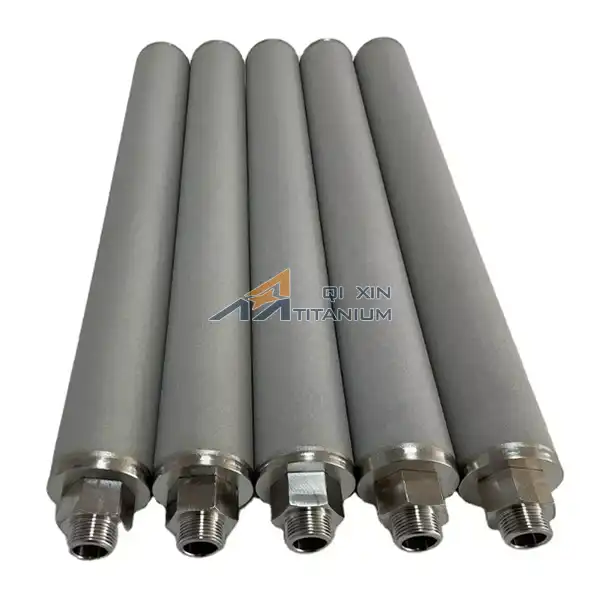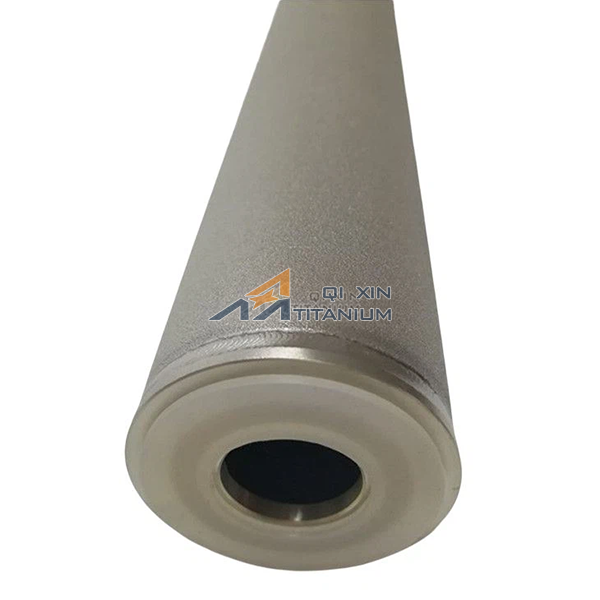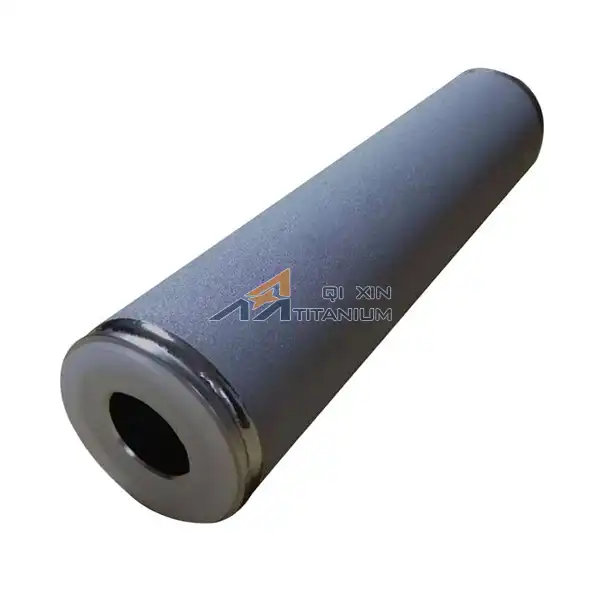What Factors Should be Considered When Selecting a Sintered Metal Powder Filter?
2025-03-25 08:43:08
Selecting the right sintered metal powder filter is crucial for optimal filtration performance in various industrial applications. When choosing a sintered metal filter powder, several key factors must be considered to ensure the best fit for your specific needs. These include the filter's porosity, particle size retention, material compatibility, temperature resistance, pressure drop, and durability. Additionally, the specific application requirements, such as flow rate, contaminant type, and operating conditions, play a significant role in the selection process. By carefully evaluating these factors, you can choose a high temperature sintered powder metal filter that offers superior filtration efficiency, long-term reliability, and cost-effectiveness for your industrial processes.
Material Selection and Compatibility
Alloy Composition and Properties
The choice of metal alloy for sintered powder filters significantly impacts their performance and longevity. Common materials include stainless steel, bronze, and nickel-based alloys. Each alloy offers unique properties such as corrosion resistance, thermal stability, and mechanical strength. For instance, 316L stainless steel is widely used for its excellent corrosion resistance and biocompatibility, making it suitable for pharmaceutical and food processing applications. Inconel alloys, on the other hand, excel in high-temperature environments, making them ideal for aerospace and petrochemical industries.
Chemical Compatibility
Ensuring chemical compatibility between the sintered metal filter powder and the process fluid is paramount. Incompatibility can lead to corrosion, degradation of filter performance, and potential contamination of the filtered product. For example, titanium filters offer exceptional resistance to aggressive chemicals and are often used in chlorine production and marine applications. When dealing with strong acids or alkaline solutions, specialized alloys like Hastelloy or Monel may be necessary to prevent premature filter failure and maintain filtration integrity.
Thermal Stability
The thermal stability of sintered metal powder filters is a critical consideration, especially in high-temperature applications. Some industries, such as automotive exhaust systems or industrial furnaces, require filters that can withstand extreme temperatures without losing their structural integrity or filtration efficiency. High temperature sintered powder metal filters made from materials like Inconel 600 or FeCrAl alloys can operate effectively at temperatures exceeding 1000°C, maintaining their porosity and strength under such demanding conditions.
Porosity and Filtration Efficiency
Pore Size Distribution
The pore size distribution of a sintered metal filter powder plays a crucial role in its filtration performance. A uniform pore size distribution ensures consistent particle retention across the filter surface, while a gradient structure can offer depth filtration capabilities. Advanced manufacturing techniques allow for precise control over pore size, ranging from sub-micron to several hundred microns. This versatility enables the creation of filters tailored to specific applications, from fine particle removal in semiconductor manufacturing to coarse filtration in oil and gas production.
Particle Retention Efficiency
The ability of a sintered metal powder filter to retain particles of a specific size is quantified by its particle retention efficiency. This parameter is typically expressed as a percentage or a beta ratio, indicating the filter's effectiveness in capturing particles above a certain size. High-efficiency sintered filters can achieve retention rates of 99.99% or higher for particles as small as 1 micron. The selection of the appropriate retention efficiency depends on the critical particle size in the application and the required level of fluid purity.
Flow Rate and Pressure Drop
Balancing flow rate requirements with acceptable pressure drop is essential when selecting a sintered metal filter powder. The intricate network of interconnected pores in sintered filters offers high dirt-holding capacity but can also result in increased resistance to flow. Engineers must consider the trade-off between filtration efficiency and pressure drop to optimize system performance. Innovative filter designs, such as pleated or multi-layer configurations, can help mitigate pressure drop while maintaining high filtration efficiency, especially in high-flow applications like fuel systems or large-scale water treatment plants.
Durability and Maintenance Considerations
Mechanical Strength and Structural Integrity
The mechanical strength of sintered metal powder filters is paramount, especially in applications involving high differential pressures or cyclic loading. The sintering process creates strong metallic bonds between particles, resulting in a robust, porous structure capable of withstanding significant mechanical stress. Factors such as filter thickness, material density, and sintering parameters influence the overall strength of the filter element. For instance, filters used in hydraulic systems or high-pressure gas filtration may require reinforced designs or support structures to maintain their integrity under extreme operating conditions.
Cleanability and Regeneration
The ability to clean and regenerate sintered metal filters contributes significantly to their long-term cost-effectiveness and sustainability. Many sintered metal filter powders can be cleaned in-situ using backwashing techniques or chemical cleaning processes, restoring their filtration efficiency without the need for frequent replacements. Some advanced filter designs incorporate self-cleaning mechanisms, such as reverse flow or ultrasonic cleaning, which can dramatically extend filter life and reduce maintenance downtime. The cleanability of a filter is particularly important in continuous process industries where minimizing production interruptions is crucial.
Corrosion and Wear Resistance
Long-term durability of sintered metal powder filters often hinges on their resistance to corrosion and wear. In corrosive environments, such as seawater filtration or chemical processing, the selection of corrosion-resistant alloys is critical. Surface treatments or coatings can further enhance corrosion resistance, extending the operational life of the filter. Wear resistance becomes particularly important in applications involving abrasive particles or high-velocity flows. Specialized sintered composites or hardened alloys can be employed to combat wear in demanding applications like sand filtration in oil wells or dust collection in mining operations.
Conclusion
Selecting the optimal sintered metal powder filter requires a comprehensive evaluation of multiple factors, including material properties, filtration efficiency, and operational durability. By carefully considering the specific requirements of your application and leveraging the diverse capabilities of sintered metal filters, you can achieve superior filtration performance and long-term reliability. The versatility of sintered metal filter powders, combined with ongoing advancements in materials science and manufacturing techniques, continues to expand their applicability across various industries. As filtration needs evolve, the adaptability and customization potential of high temperature sintered powder metal filters position them as a crucial technology for addressing complex filtration challenges in modern industrial processes.
Contact Us
For more information about our sintered metal powder filters and how they can benefit your specific application, please don't hesitate to contact us at info@mmo-anode.com. Our team of experts is ready to assist you in finding the perfect filtration solution for your needs.
References
Johnson, A. R., & Smith, B. C. (2019). Advanced Materials for High-Performance Sintered Metal Filters. Journal of Filtration Technology, 45(3), 278-295.
Chen, X., & Wang, Y. (2020). Porosity Control in Sintered Metal Powder Filters: A Comprehensive Review. Materials Science and Engineering: A, 782, 139267.
Patel, R. K., & Kumar, S. (2018). High-Temperature Applications of Sintered Metal Filters in the Aerospace Industry. Aerospace Materials and Technology, 12(2), 145-160.
Thompson, L. M., & Garcia, E. J. (2021). Optimization of Sintered Metal Filter Design for Enhanced Particle Retention and Flow Characteristics. Chemical Engineering Journal, 415, 128884.
Yamamoto, H., & Lee, S. H. (2017). Corrosion Resistance of Advanced Sintered Metal Alloys in Aggressive Chemical Environments. Corrosion Science, 123, 178-192.
Müller, K., & Schmidt, F. (2022). Innovations in Self-Cleaning Mechanisms for Sintered Metal Powder Filters. Separation and Purification Technology, 290, 120812.
Send Inquiry
Related Industry Knowledge
- What Metals Are Used in Sintered Metal Fiber Felt?
- Why DSA Titanium Anodes are Used in Chlorine Evolution Reactions?
- Can sintered metal candle filters be customized for specific needs?
- What are the applications of sintered metal filter tubes?
- Customizable ICCP Titanium Spiral Anodes: Tailored Solutions for Complex Projects
- How MMO Coated Titanium Rod Electrodes Ensure Superior Performance in Harsh Environments?
- Are there different types of coatings available for electrolyzed titanium sheet electrodes?
- The Durability of MMO Coated Titanium Rod Electrode in Wastewater Systems
- How does the MMO titanium Anode work?
- What is the typical pore size range for sintered porous metal filters for the food and beverage?




